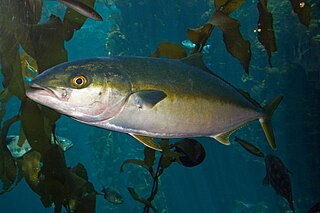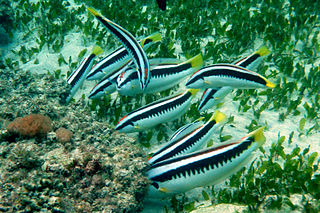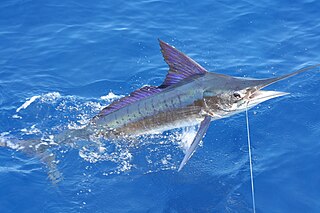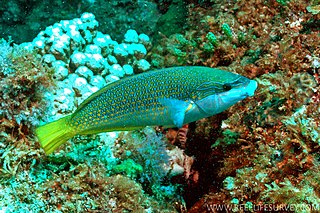
Spearfishing is fishing using handheld elongated, sharp-pointed tools such as a spear, gig, or harpoon, to impaling the fish in the body. It was one of the earliest fishing techniques used by mankind, and has been deployed in artisanal fishing throughout the world for millennia. Early civilizations were familiar with the custom of spearing fish from rivers and streams using sharpened sticks.

The Caspian tern is a species of tern, with a subcosmopolitan but scattered distribution. Despite its extensive range, it is monotypic of its genus, and has no accepted subspecies. The genus name is from Ancient Greek hudros, "water", and Latin progne, "swallow". The specific caspia is from Latin and, like the English name, refers to the Caspian Sea.

The shortfin mako, also known as the shortfin mako shark, blue pointer, or bonito shark, is a large mackerel shark. It is commonly referred to as the mako shark, as is the longfin mako shark. The shortfin mako can reach a size of 4 m (13 ft) in length and weigh 570 kg (1,260 lb). The species is classified as Endangered by the IUCN.

The white marlin, also known as Atlantic white marlin, marlin, skilligalee, is a species of billfish that lives in the epipelagic zone of the tropical and subtropical Atlantic Ocean. They are found between the latitudes of 45° N and 45° S in waters deeper than 100 m. Even though white marlin are found in bodies of water that are deeper than 100 m they tend to stay near the surface. White marlin have been found near banks, shoals, and canyons, but they are not limited to those locations. They prefer warm surface temperatures greater than 22 °C.

The billfish are a group of saltwater predatory fish characterised by prominent pointed bills (rostra), and by their large size; some are longer than 4 m (13 ft). Extant billfish include sailfish and marlin, which make up the family Istiophoridae; and swordfish, sole member of the family Xiphiidae. They are often apex predators which feed on a wide variety of smaller fish, crustaceans and cephalopods. These two families are sometimes classified as belonging to the order Istiophoriformes, a group which originated around 71 million years ago in the Late Cretaceous, with the two families diverging around 15 million years ago in the Late Miocene. However, they are also classified as being closely related to the mackerels and tuna within the suborder Scombroidei of the order Perciformes. However, the 5th edition of the Fishes of the World does recognise the Istiophoriformes as a valid order, albeit including the Sphyraenidae, the barracudas.

The yellowtail amberjack, yellowtail kingfish, hiramasa or great amberjack is a large fish found in the Southern Ocean. Although previously thought to be found in all oceans and seas, recent genetic analysis restricts S. lalandi proper to the Southern Hemisphere waters. However, they are found in Northern Hemisphere waters during certain times of the year. The fish was given its name by Monsieur de Lalande, a naturalist who first informed zoologist Achille Valenciennes of the existence of this species. His reason for the use of the word Seriola to name the fish is uncertain, but the second word lalandi was derived from his surname.

The comb wrasse or combfish is a species of wrasse of the genus Coris, native to the western Pacific Ocean off eastern Australia and around offshore islands off north eastern New Zealand. This species can be found in areas with sandy substrates around rock reefs at depths from 3 to 25 m. It can reach 25 cm (9.8 in) in total length. This species can also be found in the aquarium trade.

The black marlin is a species of marlin found in tropical and subtropical areas of the Indian and Pacific Oceans. Reaching lengths of over 4.5 m (15 ft), it is one of the largest marlins and also one of the largest bony fish. Marlin are among the fastest fish, but speeds may be exaggerated in popular media, such as reports of 132 km/h (82 mph). A 2016 study estimated maximum swimming speeds from muscle contraction times, which in turn limit the tail-beat frequency; the study suggested a theoretical upper limit for the black marlin's burst speed of 36 kilometres per hour (22 mph). Black marlin are fished commercially and are also a highly prized game fish. Black marlins have been known to drag Maldivian fishing boats of the ancient times for very long distances until it got tired; and then it would take many hours for the fishermen to row or sail back home.

The striped marlin is a species of marlin found globally in tropical to temperate oceans not far from the surface. It is a desirable commercial and game fish, although conservation measures are in place to restrict its commercial landings. An epipelagic predator, it hunts during the day in the top 100 metres (330 ft) or so of the water column, often near the surface. One of its chief prey is sardines.

The banded bellowsfish, banded yellowfish, banded snipefish, or bluebanded bellowsfish, is a species of fish of the family Macroramphosidae, found in southern oceans at depths of 35 to 1,000 m. Its length is up to 30 cm (12 in).

The black flounder, also known by the Māori language name mohoao, is a flatfish of the genus Rhombosolea, found around New Zealand in shallow enclosed waters and coastal freshwater lakes. Its adult length ranges from 20 to 45 cm.
The black ruff is a medusafish, the only member of the genus Centrolophus. It is a pelagic fish found in all tropical and temperate oceans at depths of 0 to 1,000 m. Its length is typically up to 60 cm (24 in), but it may reach 150 cm (60 in). Other common names include rudderfish and blackfish.

The elegant wrasse, Anampses elegans, is a species of wrasse native to the Pacific Ocean from Australia and New Zealand eastward to Easter Island. This species prefers lagoons and can also be found on coastal reefs at depths from 2 to 35 m. This species can reach a length of 29 cm (11 in). It can be found in the aquarium trade.
The spearfish remora is a species of remora with a worldwide distribution in tropical and subtropical seas. Remoras attach themselves to other fish with a sucker on the head and this fish is almost exclusively found living on billfishes or swordfishes, and sometimes on sharks.

The white-spotted Izak or African spotted catshark is a catshark of the family Scyliorhinidae. It is found in the western Indian Ocean off the coasts of Natal, South Africa, southern Mozambique, Madagascar, Kenya, and Tanzania between latitudes 4° S and 37° S, at depths of between 220 and 440 m. It can grow up to 35 cm in length.

The roundscale spearfish is an Istiophoridae species of marlin living in the epipelagic zone of the Atlantic Ocean. It has long been misidentified as white marlin but can be differentiated thanks to their scale shapes that gives its name. Not much is known about this species. It could reach a length of 160 cm and 21,5 kg and has no conservation status yet due to a lack of data.

Tetrapturus is a genus of marlins commonly called spearfish, found in tropical and subtropical oceans throughout the world. Some are popular sport fish in big-game fishing.

The longbill spearfish is a species of marlin native to the Atlantic Ocean where it is found above the thermocline in open waters between 40°N and 35°S. This species can reach a length of 254 centimetres (100 in) FL and the maximum weight recorded is 58 kilograms (128 lb). It feeds on pelagic fishes such as needlefish, tuna, and jack, as well as squids. They spawn once a year. The specific name honours the Florida game fisherman and taxidermist Albert Pflueger Sr, who died in 1962.

The Mediterranean spearfish is a species of marlin native to the Mediterranean Sea where it is particularly common around Italy, although there is a probable record of one caught off Madeira. It is an open-water fish, being found within 200 metres (660 ft) of the surface. This species can reach a length of 240 centimetres (94 in) TL. The heaviest recorded specimen weighed in at 70 kilograms (150 lb) This species is of minor importance to commercial fisheries.



















